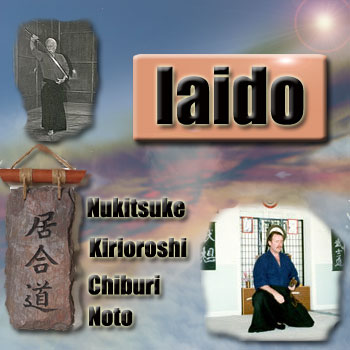|
|
|
 |
|
The arts of the sword as we know them today probably began with Iizasa Choisai the founder of the Tenshin Shoden Katori Shinto Ryu. Also during the 15th century Hayashizaki Jinsuke Minamoto no Shigenobu collected techniques from different warrior schools into a form he called Iai Jutsu or Iaido. He did this after a dream he had. The difference was that the new forms were all defensive. You responded to an (surprise-) attack by drawing your sword and cutting down your enemies. The term Iai Jutsu does not, translate into "The art of drawing the sword", but rather "Instant Awareness". You should be able to respond to any threat instantaneously and in such a way be able to avoid being attacked. Therefore Iaido is the art of reacting to a surprise attack by counter attacking with a sword.
TENSHIN RYU SYLLABUS The full Tenshin Ryu syllabus can be downloaded HERE Comprises of the complete understanding of 1. Dojo etiquette 2. Kamiza procedure. 3.Care of the Katana (Iaito) and the naming of all parts of the sword. 4. Sixteen standing forms (Tachi Waza). 5. Thirteen Kneeling forms (Seiza Waza). 6. Two person Kata (Eight forms with Katana). 7. Two person Kata (Eight forms with Wakazashi).
Iaido can be segmented into four main parts as follows. 1. Nukitsuke - This is the first strike, though single handed, it should be effective and performed with focus and purpose. It should make kirioroshi unnecessary. 2. Kiritsuke Kirioroshi - Main two handed cut, the definative cut, carried out with power and control. 3. Chiburi - Blood shake off. Maximum zanshin as the confrontation may not be over. 4. Noto - Re-sheathing of the blade. again maximum Zanshin. Alongside the physical aspects of the forms it could be argued are the mental aspects of swordsmanship. To become one with the sword and achieve a state of "No-Mind", it is necessary to have an understanding of Metsuke (correct use of the eyes), Maai (combative distance) and Ma (timing).
The Five Kamaes ( Attitudes )
Finally a kamae not usually listed with the five main ones is Kamae-Otoku, this is the attitude of mutual withdrawal. the point of the sword faces the opponents knee with the wrists exposed.
Swordsmanship and Buddhism have always been connected. Bushido comprises of Buddhism, Zen, Confucianism and Shintoism. Priests became warriors and warriors became priests " Tsune ni itte kyu ni awasu " ("Wherever you are and what ever you are doing always be prepared")
PARTS OF THE KATANA (IAITO)
|
||||||||||||||||||||||||||||||||||||||||||||
|
|||||||||||||||||||||||||||||||||||||||||||||
